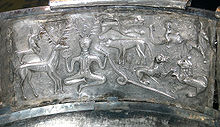Eidring
Utensils known as Eidring (or Schwurring - mytholog. Also Ullers Ring - Swedish Edsring ; Danish Edsring ) appear in depot finds of the Bronze Age Northern Circle. Later they also appear as a representation. They assigned their bearers to a religious community, served ritual purposes or were symbols of power.
Naming
They were given the name "Eidring" from the founder of Danish prehistory research, Christian Juergensen Thomsen . Although somewhat incongruous, it has been retained to identify a particular type of ring. The rings made of bronze or gold from the depots date from the Bronze and Iron Ages , the 8th to 7th centuries BC. BC, are around 1500 years older than the term first documented in the saga .
Finds
The spread of the rings is clearly related to the Baltic Sea region . According to Gustaf Kossinna , 47 oath rings were found in northern Germany (up to 1917) (published in 1917 in Mannus 8). Of these, 29 (i.e. over 60%) are hollow rings, while of the 27 found back then in Denmark (e.g. No. Kongenslev) (today over 60; 16 on Fyn alone - four in Ny Stenderup) only nine (i.e. one Third) are hollow.
- Unknown location 2,
- Altmark 2,
- West Prussia 3,
- Schleswig-Holstein 6, ( Fahrenkrug , Großenaspe shows the Eidring in the coat of arms, Wittenborn, found in the Baß part of the municipality in 1860).
- Brandenburg 7, (including Bredow, Meyenburg-Schabernack)
- Mecklenburg 8, (including Baumgarten 1895, Granzin 1867, Jülchendorf 1853, Retzin (probably 1848) Wohlenhagen (before 1864), Woosten 1850)
- Pomerania 19, (the high number is probably due to the close proximity to the Swedish distribution area)
- Saxony-Anhalt 1, a new find from 2009 in Könnern an der Saale.
- Ring made of Strobjehnen, East Prussia 1798.
Ring representations
The Gundestrup cauldron probably shows the oldest depiction of a ring that a god is holding in his hand. The richly decorated cauldron dates from the 5th to 1st century BC. Chr.
The rings that men hold up on some Gotland picture stones (Hunnige, Tängelgårda I), as well as the rider on the choir portal of the church of Fardhem (12th century), should correspond to mythological symbolism. This also applies to the swords, which were often provided with rings during the Migration Period and the Vendel Period .
Mythical background
Rings that were assigned magical powers ( Draupnir and Sveagris) are reported in Norse myths and legends. One of the Edda chants reads: “Odin took the oath on a ring, who should trust his promises now?” Sagas tell about King Adil's ring “Sveagriss”, the tribal symbol of the Svear. The ring was owned by a royal family who ruled central Sweden until the end of the 11th century. Such rings were, as reported in English annals, as symbols of honor and dignity of the Scandinavians. Today it is assumed that the gold rings were the jewelry of important men and were already worn on the left upper arm in the younger Bronze Age . The rings known as torques in the Celtic region were later worn as necklaces. As a cult object with a tradition of over 1200 years, they were still part of representations at the end of the Viking Age (1050 AD) (especially in Sweden).
See also
literature
- Heinrich Beck, Gernot Jacob-Friesen : Eidring. In: Reallexikon der Germanischen Altertumskunde (RGA). 2nd Edition. Volume 6, Walter de Gruyter, Berlin / New York 1986, ISBN 3-11-010468-7 , pp. 549-553.
- Charlotte Fabech: Sydskandinaviske offerfund som kilde til jernalderens religion and ideologi. In: Lars Larsson, Bożena Wyszomirska (ed.): Arkeologi och Religion. Rapport fran arkeologi-dagarna 1989 (University of Lund, Institute of Archeology, Report series No. 34) Lund pp. 243-269.
- Wladimir Iwanowitsch Kulakow: The gold ring from Strobjehnen and its meaning in the network of relationships between Prussians and steppe peoples (p. 204–212).
- M. Schultze: The golden oath rings of the Prenzlau district . In: HK 1930, pp. 70-73.
- Karsten Kjer Michaelsen: Politics bog om Danmarks oldtid . Copenhagen 2002 ISBN 87-567-6458-8 , pp. 48, 290.
Individual evidence
- ↑ Sveagris (also Svíagríss; Sveernes Schwein), is a golden ring described in the Snorri Edda and the Rolf Krake Saga. It is an heirloom of the Swedish Ynglinger kings. In the saga, King Adil loses him to Rolf Krake. The god Freyr is associated with the Ynglinger kings and his pig Gullinborsti was sacred. The Sveagris was probably shaped like a pig


